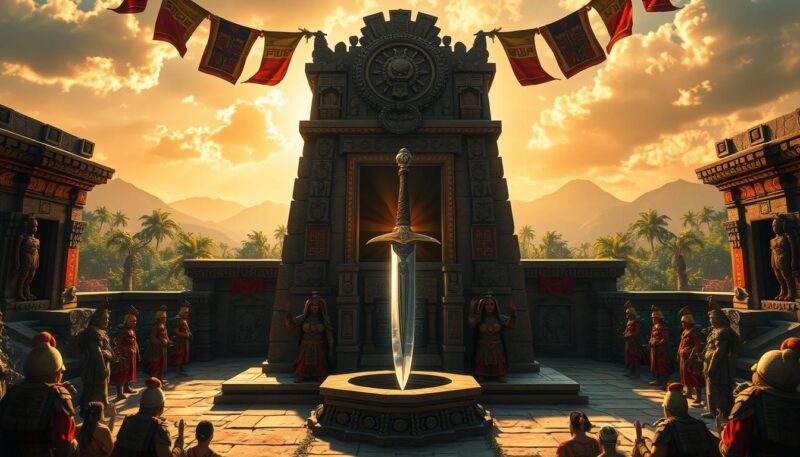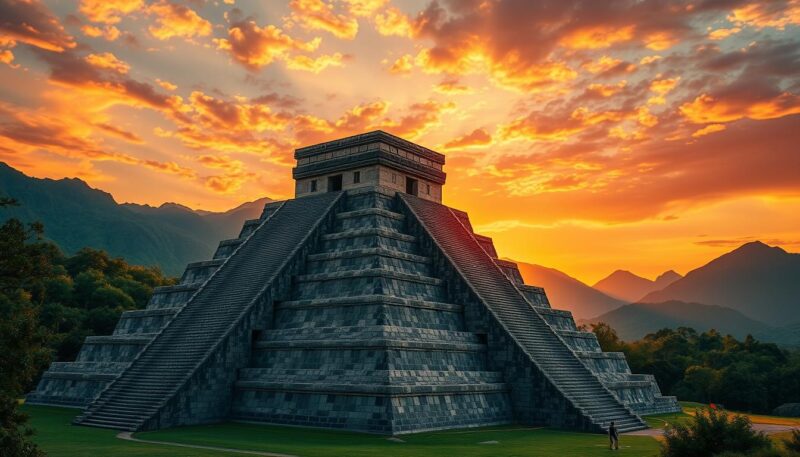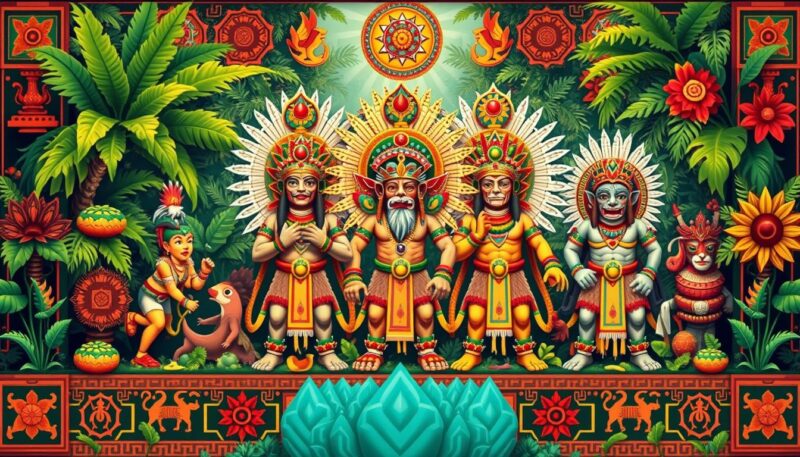The Aztecs, or Mexica, represent one of the most fascinating civilizations in ancient history, often captivating the imagination of travelers and historians alike. With a remarkable reign that extended for over 300 years, they built one of the largest empires in Mesoamerica before the arrival of Spanish conquistadores in the early 16th century. Tenochtitlán, their capital, was not just a city; it was a thriving hub that surpassed many European cities of the time in terms of population and sophistication.
The Aztec civilization was rich in Aztec culture, from their intricate social hierarchies to their compulsory education systems that varied based on gender and social class. Their advanced agricultural techniques and extensive trading networks laid the groundwork for modern Mexican society. However, it is essential to understand the dual nature of their society, which included brutal practices, such as human sacrifice. It is estimated that around 20,000 individuals were sacrificed each year, a macabre ritual more pronounced during the construction of their significant temples.
Delving deeper into surprising Aztec history, one finds an intricate tapestry of beliefs and practices, including a complex understanding of time, encapsulated in their calendar system. The Aztecs believed in four mythological eras, with the current era being the Fire Sun, which they foresaw as destined for an eventual cataclysm. This profound belief influenced many aspects of their daily lives and interactions with the cosmic forces they revered.
The Aztec gods and mythology played a significant role in all facets of their civilization, from education to warfare. Society was organized around worshipping these deities, each requiring distinct rituals and offerings, reflecting their societal values and hierarchy. The extensive organization of the priesthood underscores the importance of religion within Aztec culture—a testimony to how their beliefs were woven into the very fabric of their everyday life.
As we explore the intriguing facts surrounding the Aztecs, their culture, wars, and gods, we will uncover layers of historical significance that shaped not only their civilization but continue to influence the world today.
Overview of the Aztec Civilization
The Aztec civilization, known for its rich cultural tapestry, began to take shape in the Valley of Mexico as early as 1325 AD. The Mexica tribe, which would become the Aztecs, migrated to this region from a mythical place called Aztlan. Through adaptability and ingenuity, they laid the foundations for one of the most significant societies in Mesoamerican history.
The Origins of the Aztecs
The journey of the Aztecs commenced after the collapse of earlier civilizations such as the Toltecs. Their migration into the region occurred around the 12th century CE, facilitated by the destruction of Tula, their previous stronghold. Establishing Tenochtitlán on an island in Lake Texcoco marked the beginning of their rise. The iconic image of an eagle, perched on a nopal cactus with a serpent in its beak, became a symbol of this founding moment and can be found on modern Mexico’s national flag.
The Rise of Tenochtitlán
Tenochtitlán emerged as a vibrant capital city, thriving through trade and agricultural innovations that supported a growing population. Its construction predominantly occurred between the 14th and 16th centuries, showcasing monumental architectural achievements. The city’s urban organization allowed for an efficient distribution of resources, contributing to its status as a major economic center. Daily life in Tenochtitlán revolved around bustling marketplaces, schools, and a structured social environment that fostered cultural diversity.
The Structure of Aztec Society
The Aztec social structure was intricately layered, encompassing distinct classes such as nobles, priests, warriors, and commoners. This hierarchy allowed for a complex legal system and systems of tribute. Nobles held significant influence, while commoners engaged primarily in agriculture, trade, and military service. Religion played a vital role in everyday life, and the society was built on strong ethical and moral codes that guided interactions among different classes. Through this structure, the Aztec empire rise signified a balance between power, duty, and collaboration.
Aztec Wars and Human Sacrifice
The Aztec war culture was an intricate blend of strategy, religion, and societal norms. Warfare played a crucial role not only in territorial expansion but also in affirming social hierarchies. Legendary Aztec leaders such as Moctezuma II utilized warfare to establish and maintain dominance over a vast territory. The military was not only a means for conquest but also a pathway to honor and prestige within Aztec society, where the quest for captives was paramount.
Military Culture of the Aztecs
The Aztecs engaged in a unique form of warfare known as the “Flower Wars.” These battles were less about outright conquest and more focused on capturing enemy combatants for sacrifice. The flower wars emerged after droughts in the mid-1450s led to food shortages, prompting ritualized conflict aimed at acquiring sacrificial victims. Captives obtained through these wars were often viewed with reverence, as dying in battle was considered an honorable fate, enhancing their value in ritualistic practices.
Human Sacrifice Practices
Central to Aztec culture was the practice of Aztec human sacrifice. These rituals were steeped in cosmological beliefs that dictated the need for human offerings to sustain the universe and appease the gods. Archaeological findings have shed light on this dark aspect of Aztec life. At the Hueyi Tzompantli near Templo Mayor, over 600 skulls were discovered, providing stark evidence of the scale of sacrifices performed.
The sacrificial rites often involved heart extraction atop temples, where priests, assisted by others, executed the act with ceremonial flint knives. The displayed heads on tzompantli served as both a grim reminder of the fate awaiting captives and a display of power. This ritual cannibalism, corroborated by archaeological evidence and historical accounts, highlights how intertwined violence and spirituality were within Aztec society. Such practices were socially legitimized, celebrated, and deemed essential for the continuation of life. The Aztecs believed these rituals sustained the gods, which in turn maintained natural order and prosperity.

Temple of the Sun and Moon in Mexico: An Architectural Marvel
The Temple of the Sun and Moon in Mexico represents a pivotal achievement in Aztec architecture, showcasing the grandeur and significance of these monumental structures. Among the most vital sites is Templo Mayor, which served a central role in the religious life of the Aztecs and exemplified their architectural prowess.
The Significance of Templo Mayor
Templo Mayor functioned as the primary temple of Tenochtitlán, reflecting the Aztecs’ deep religious beliefs and social hierarchy. Dedicated to the deities Huitzilopochtli and Tlaloc, it was more than a place of worship; it symbolized the power of the Aztec civilization. The two pyramids within the complex used for different ceremonies illustrate the dualistic nature of Aztec religious practices and the importance of human sacrifices in maintaining cosmic balance.
Construction Techniques and Cultural Influences
The advanced construction techniques behind Templo Mayor and similar monuments reveal the ingenuity of Aztec engineers. Built primarily from volcanic stone, these structures addressed the challenges posed by Tenochtitlán’s marshy terrain. Innovative methods included creating stone channels for efficient water management and constructing artificial islands, which supported agriculture.
The architectural design and features of Templo Mayor not only emphasize its religious importance but also demonstrate an understanding of aesthetics and functionality. The alignment of these pyramids with celestial events reflects the sophisticated astronomical knowledge of the Aztecs, influencing subsequent Mesoamerican civilizations.

| Structure | Height (Feet) | Base Dimensions (Feet) | Significance |
|---|---|---|---|
| Pyramid of the Sun | 216 | 720 x 760 | Third-largest pyramid in the world |
| Pyramid of the Moon | 140 | 426 x 511 | Site of important rituals and sacrifices |
| Templo Mayor | Variable | Multiple levels | Main temple in Tenochtitlán, reflecting power and spirituality |
Conclusion
The Aztec civilization remains one of the most intriguing narratives in the history of Mesoamerica. Their legacy, richly woven with layers of art, agriculture, and social hierarchies, highlights a culture that was both advanced and complex. The Spanish conquest of the Aztecs in 1521 not only marked the downfall of an empire but also set the stage for a fascinating exploration of their enduring influences seen in modern-day Mexico. Surprising Aztec history continues to captivate the imaginations of historians and travelers alike.
As illustrated by their ingenious farming techniques such as chinampas, the Aztecs made substantial contributions to agricultural practices that persist today. Likewise, their architectural landmarks, including the remarkable temples, showcase a high level of engineering and artistry that was unprecedented for their time. Whether it’s the awe-inspiring Pyramid of the Sun or the rich cultural significance behind Templo Mayor, Aztec treasures provide a glimpse into their extraordinary world.
With ongoing archaeological efforts shedding light on their past, it’s evident that this ancient civilization’s impacts are far from forgotten. With every discovery, we uncover more about their resilience and innovation, enriching our understanding of human civilization’s capacity to adapt and flourish. As we delve into these remarkable findings, we continue to honor the vibrant spirit of the Aztecs and their place in history.

